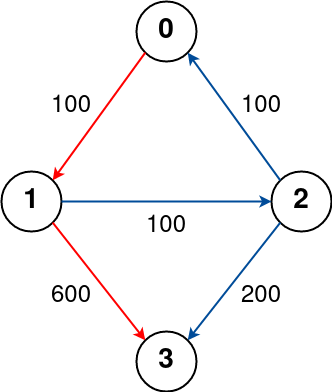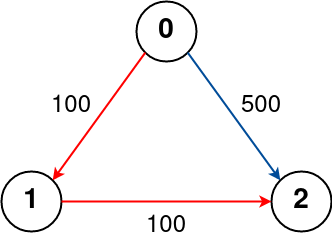Cheapest Flights Within K Stops
MediumThere are n cities connected by some number of flights. You are given an array flights where flights[i] = [fromi, toi, pricei] indicates that there is a flight from city fromi to city toi with cost pricei.
You are also given three integers src, dst, and k, return the cheapest price from src to dst with at most k stops. If there is no such route, return -1.
Example 1:

Input: n = 4, flights = [[0,1,100],[1,2,100],[2,0,100],[1,3,600],[2,3,200]], src = 0, dst = 3, k = 1 Output: 700 Explanation: The graph is shown above. The optimal path with at most 1 stop from city 0 to 3 is marked in red and has cost 100 + 600 = 700. Note that the path through cities [0,1,2,3] is cheaper but is invalid because it uses 2 stops.
Example 2:

Input: n = 3, flights = [[0,1,100],[1,2,100],[0,2,500]], src = 0, dst = 2, k = 1 Output: 200 Explanation: The graph is shown above. The optimal path with at most 1 stop from city 0 to 2 is marked in red and has cost 100 + 100 = 200.
Example 3:

Input: n = 3, flights = [[0,1,100],[1,2,100],[0,2,500]], src = 0, dst = 2, k = 0 Output: 500 Explanation: The graph is shown above. The optimal path with no stops from city 0 to 2 is marked in red and has cost 500.
Constraints:
1 <= n <= 1000 <= flights.length <= (n * (n - 1) / 2)flights[i].length == 30 <= fromi, toi < nfromi != toi1 <= pricei <= 104- There will not be any multiple flights between two cities.
0 <= src, dst, k < nsrc != dst
Solution
Clarifying Questions
When you get asked this question in a real-life environment, it will often be ambiguous (especially at FAANG). Make sure to ask these questions in that case:
- What are the constraints on the number of cities `n`, the number of flights, the values of `fromi`, `toi`, `pricei`, `src`, `dst`, and `k`? Are there any upper limits I should be aware of?
- Is it possible for there to be cycles in the flight routes?
- Is it guaranteed that `src` and `dst` are valid cities (i.e., within the range [0, n-1])?
- If there are multiple cheapest paths with at most `k` stops, is any one acceptable, or is there a specific path that should be preferred?
- Can the `pricei` be zero or negative?
Brute Force Solution
Approach
We want to find the cheapest flight route from a starting city to a destination city, with a limit on the number of connecting flights. The brute force approach explores every possible flight path to find the cheapest one that meets our requirements.
Here's how the algorithm would work step-by-step:
- Start at the departure city.
- Consider every flight leaving from that city as a potential first flight.
- For each of those first flights, look at all the flights leaving from the city you landed in.
- Continue this process, exploring all possible flight combinations, keeping track of the total cost of each route.
- Stop exploring a route if it exceeds the maximum number of allowed connecting flights or if the route arrives back at a city already visited (to avoid endless loops).
- Once you have explored all possible routes up to the allowed number of connections, compare the total costs of all routes that reached the destination city.
- The route with the lowest total cost is your answer.
Code Implementation
def find_cheapest_flights_brute_force(number_of_cities, flights, source, destination, max_stops):
cheapest_price = float('inf')
def depth_first_search(current_city, stops_remaining, current_cost, visited):
nonlocal cheapest_price
if current_city == destination:
cheapest_price = min(cheapest_price, current_cost)
return
if stops_remaining < 0:
return
# Need to check for cycles to avoid infinite recursion
if current_city in visited:
return
visited.add(current_city)
for start_city, end_city, price in flights:
if start_city == current_city:
# Explore the next city with reduced stops and increased cost
depth_first_search(end_city, stops_remaining - 1, current_cost + price, visited.copy())
visited.remove(current_city)
# Initialize the depth first search to find the min price
depth_first_search(source, max_stops, 0, set())
if cheapest_price == float('inf'):
return -1
else:
return cheapest_priceBig(O) Analysis
Optimal Solution
Approach
To find the cheapest flight with a limited number of stops, we explore possible routes step-by-step, always tracking the lowest price we've found so far for each city after a certain number of stops. We use this information to intelligently discard routes that are already more expensive than known cheaper options.
Here's how the algorithm would work step-by-step:
- Start at the origin city with a cost of zero.
- For each possible number of stops, from zero up to the maximum allowed:
- Go through all available flights, considering only flights that depart from cities we reached in the previous round of stops.
- For each flight, calculate the total cost to reach the destination city via this flight.
- If the total cost is lower than the cheapest price we've previously found to reach that destination city with the current number of stops, update the cheapest price.
- After considering all flights for a specific number of stops, move on to the next number of stops.
- After exploring all possible routes within the allowed number of stops, the cheapest price recorded for the destination city is the answer. If no route was found, the answer is -1.
Code Implementation
def find_cheapest_price(number_of_cities, flights, source_city, destination_city, max_stops):
cheapest_prices = {}
cheapest_prices[source_city] = 0
for current_stop in range(max_stops + 1):
temp_cheapest_prices = cheapest_prices.copy()
for start_city, end_city, price in flights:
if start_city in cheapest_prices:
# Only process flights departing from reached cities.
current_price = cheapest_prices[start_city] + price
if end_city not in temp_cheapest_prices or current_price < temp_cheapest_prices[end_city]:
# Found a cheaper route to the destination.
temp_cheapest_prices[end_city] = current_price
cheapest_prices = temp_cheapest_prices
# Return the cheapest price if found.
if destination_city in cheapest_prices:
return cheapest_prices[destination_city]
else:
return -1Big(O) Analysis
Edge Cases
| Case | How to Handle |
|---|---|
| flights is null or empty | If flights is null or empty, and src != dst return -1, else if flights is null or empty and src == dst return 0. |
| n is zero or negative | If n is non-positive, there can be no valid path, return -1. |
| k is negative | If k is negative, it is an invalid input, return -1. |
| src is equal to dst | If src is equal to dst, the cost is 0 regardless of the number of stops, so return 0. |
| No path exists from src to dst within k stops | If after exploring all possible paths within k stops, dst is not reached, return -1. |
| Integer overflow during price calculation | Use long data type to store prices during calculation and before returning, or check if the running total exceeds a maximum amount (like Integer.MAX_VALUE). |
| Graph contains cycles | The BFS/Bellman-Ford algorithm naturally handles cycles by tracking the number of stops/iterations and ensuring it doesn't exceed k. |
| Maximum values for n, k and prices that could lead to TLE (Time Limit Exceeded) | Optimize the algorithm to use Dijkstra or Bellman-Ford with efficient priority queue or early stopping conditions to avoid unnecessary computations. |